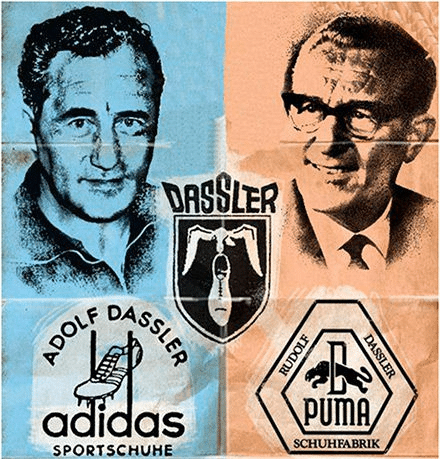A 70 year old rivalry
In Monday’s assembly we heard the story of two brothers whose falling out with each other led to one of the most enduring sportswear rivalry in history.
Adi and Rudolf Dassler were born in the small German town of Herzogenaurach at the end of the 19th Century. When the First World War broke out in 1914, Rudolf joined up and went away to fight. Adi was only 13 so stayed at home and learned how to repair shoes. At the end of the war, the brothers founded the Dassler Sports Shoe Factory, with Adi focusing on manufacturing and Rudolf on sales. By 1936, the company had grown and sponsored the US athlete Jesse Owens, who famously won four gold medals at the Berlin Olympics despite the prejudice and discrimination directed against him as a black athlete by the Nazi regime that hosted the games.
This success led to over 200,000 sales of the Dassler brothers’ spiked running shoes.
War again intervened with dramatic consequences for the brothers, however – Rudolf again went away to fight but Adi was given an exemption so he could repurpose the factory to make military equipment. There were rumours that Rudlof had had an affair with Adi’s wife, and that he suspected his brother wanted to take sole control of the business. Whatever happened between them, when he was captured by American soldiers towards the end of the war his brother made a statement claiming he was a Nazi. He was released after only one year, partly because his captors found out he was involved in equipping Jesse Owens with his spikes. In turn, Rudolf claimed to the authorities in the post-war period that Adi had overseen the production of weapons in the family factory, although he was eventually cleared.
Adi kept the original factory and Rudolf set up a new business. Adi Dassler’s became known as Adidas, and Rudolf called his company Puma. The rift was now set.
The 1954 World Cup was the first high-profile clash between the two companies – Rudolf supplied Puma boots to the Hungarian team while Adi kitted out the West Germans. Hungary were the favourites, having been undefeated in 31 matches leading up to the tournament, which included a 6-3 defeat of England at Wembley the previous year. They were also full-time professionals and were known as the most innovative and exciting side in the world. The Germans were semi-professional and had only been admitted to Fifa in 1950. Hungary defeated West Germany 8-3 in the Group Stage but – in a match known as the Miracle of Bern, named after the city in which it was played, the tables were turned in the final and West Germany became world champions with a 3-2 victory. Whether the fact that their Adidas boots included screw-in studs that could be changed depending on the conditions played any part in this victory we’ll never know, but Adi had come out on top in this particular battle of the brothers.
But Rudolf – and Puma – weren’t finished. When the 1970 World Cup came around, the biggest team was Brazil and their biggest star was Pele. Adidas and Puma made an agreement not to sponsor Pele to avoid getting into a bidding war, that was until Puma broke the pact and offered Pele $120,000 to kneel down and tie his laces just before Brazil’s Quarter-Final match kicked off. The cameras all zoomed in to see Pele tying the laces on his Puma boots, which boosted sales around the world. Puma had their revenge.
The population of Herzogenaurach largely worked in one of the two factories and people chose a side and had nothing to do with the other. The rivalry became suffused with other traits as well – Puma was linked with Catholics and Conservatives and Adidas with Protestants and more progressive politics.
Rudolf and Adi died just four years apart, in 1974 and 1978 respectively. There was no public reconciliation but there is a rumour that they met, in secret, before Rudolph’s death. The brothers are buried in the town’s graveyard – at opposite ends. In 2009, however, after a rivalry that stretched back 60 years, the two companies reconciled, an event that was marked by a friendly football match. Such was the depth of the rivalry that the ball was co-branded and the game played between the management and employees, so as not to risk one company beating the other.
Neither company is still owned by any family members, and their factories are spread around the world, but the Headquarters of both Puma and Adidas remain in the small German town where this most fierce of rivalries developed.
And in case you’re wondering, the bosses won the 2009 match 7-5.
Have a great weekend
Best wishes
Michael Bond




